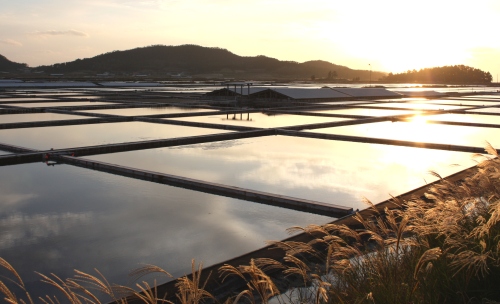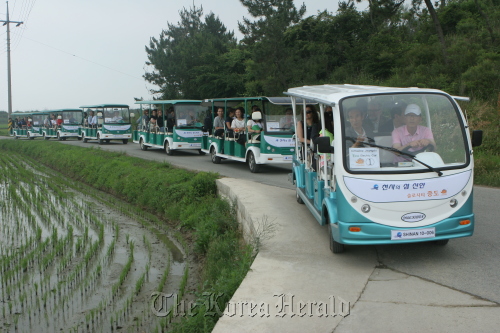Some grow impatient for quick progress in go-slow Jeungdo
JEUNGDO ― On this small island off the shore of Sinan County, South Jeolla Province, postmen don’t bother reading the addresses written on the envelopes. For them, the names are more than enough. “Everyone knows everyone here,” says a resident of Jeungdo, Korea’s first “slow city.”
“Even if you get the address wrong, your mail will still be delivered to the right person.”
On Jeungdo, you won’t find many things that you’d normally expect to see in a town. There are no malls, no bars, and no traffic lights. There are two taxis, though, and two schools, and one karaoke with an outdated machine. In spite of the recent dramatic changes, Jeungdo is still “slow” in its own ways.
Most of its landscape is vast rice paddy fields, and exquisite salt farms that are especially stunning during sunset. The Taepyeong Salt Farm, which is registered cultural heritage No. 360, is the largest salt field in Korea. It was first created in 1953 for the relief of refugees and to boost domestic salt production after the Korean War. The farms had charmed the members of “Cittaslow,” ― the Italian-based network of cities that promote slow food and life ― back in 2007, which eventually led to the designation of Jeungdo as the first slow city in Asia that year. As of 2011, 10 slow cities have been designated in Korea.
JEUNGDO ― On this small island off the shore of Sinan County, South Jeolla Province, postmen don’t bother reading the addresses written on the envelopes. For them, the names are more than enough. “Everyone knows everyone here,” says a resident of Jeungdo, Korea’s first “slow city.”
“Even if you get the address wrong, your mail will still be delivered to the right person.”
On Jeungdo, you won’t find many things that you’d normally expect to see in a town. There are no malls, no bars, and no traffic lights. There are two taxis, though, and two schools, and one karaoke with an outdated machine. In spite of the recent dramatic changes, Jeungdo is still “slow” in its own ways.
Most of its landscape is vast rice paddy fields, and exquisite salt farms that are especially stunning during sunset. The Taepyeong Salt Farm, which is registered cultural heritage No. 360, is the largest salt field in Korea. It was first created in 1953 for the relief of refugees and to boost domestic salt production after the Korean War. The farms had charmed the members of “Cittaslow,” ― the Italian-based network of cities that promote slow food and life ― back in 2007, which eventually led to the designation of Jeungdo as the first slow city in Asia that year. As of 2011, 10 slow cities have been designated in Korea.

Even in 2007, the only way for anyone to visit the island was to take a ferry. From Mokpo, the closest big city from Jeungdo, it would take a good three hours. Such an isolated location had left Jeungdo unknown to the rest of Korea for a long-time. It was a peaceful, quiet island with a tight community mostly made of working farmers. Even today, over 90 percent of its population is farmers, not fishermen, as the island is surrounded by a wide belt of intertidal mudflats.
Being the first slow city of Asia, along with the completion of the bridge that connects the island to the peninsula ― which opened last year ― brought many changes to Jeungdo. As the number of visitors increased dramatically, the island faced more demand for accommodations and tour packages. This had both positive and negative impacts on the island, placing Jeungdo somewhere in between further development and the expected “slowness.”
Just one year before Jeungdo became a slow city, a corporate resort named El Dorado opened. A growing number of people who live outside of Jeungdo have since started buying properties on the island, and building rental homes for tourists.
To benefit and engage local residents in the newly-thriving tourism of the island, the regional government offered financial support for 30 local households last year, to renovate their private homes into lodging houses. Each household was given 10 million won. Another 30 households received the same support this year.
Local residents also founded a travel agency, called Gilbeot, generating many hands-on tour programs featuring the Taepyeong Salt Farm and mudflats. They’ve also launched a campaign for making Jeungdo a non-smoking, environmentally-friendly town. Almost all lodging houses owned by local residents offer bikes for free, while almost all stores have stopped selling cigarettes.

Yet Lee Hong-young, the chairman of Cittaslow Korea Network of Jeungdo branch, said most of the farmers on the island aren’t affected by the booming tourism. Lee, who took an unpaid job at Cittaslow in February, has been a life-long farmer on Jeungdo, where he was born and grew up.
“I’d say the lodging house project and local tour agency have been a success,” Lee said. “But this slow city movement hasn’t done much for our farmers. Most of the local residents can’t afford to buy properties on this island as outsiders do. I am looking into more ways to engage local farmers to benefit from being slow.”
Lee Jong-hwa, the representative of the local tour agency Gilbeot, on the other hand, has been receiving complaints from visitors and scholars, that Jeungdo isn’t “slow” enough. One of the scholars that contacted him pointed out that most buildings on Jeungdo are modern-day residential ones, carrying no particular aesthetic values. Unlike other slow cities in Korea, such as Changpyeong of South Jeolla Province or Yesan of South Chungcheong Province, Jeungdo doesn’t have any traditional Korean houses or ancient Buddhist temples. “He said we should in fact ‘create’ traditional homes, at least just to show the visitors, to serve the purpose of being a slow city,” Lee told The Korea Herald. “But we cannot live a lie for the sake of a slow city.”
“We wanted to become a slow city because we wanted to survive,” said an administrative officer in one of the dong offices on Jeungdo, who wanted to remain anonymous. “The whole point is to make profit while promoting the slow lifestyle as much as we can. No one on this island would do farming with ancient tools and a working cow, just to show our visitors that we are living a slow life. How can one ‘stage’ slowness? It’s also an ethical issue.”
Sohn Dae-hyun, head of the Korea Slow City organization, said Jeungdo is slow enough by having its salt farms.
“Salt farms are the biggest charm of Jeungdo, and it was the biggest reason why it was designated as a slow city to begin with,” he said. “It’s certainly not reasonable to create something artificial just to attract tourists.”
Jeungdo, along with three other slow cities in Korea that were designated in 2007 ― Jangheung, Wando, Cheongsando, and Damyang, all in South Jeolla Province ― will be revisited by the headquarters of Cittaslow in Italy, next year. “There is a chance that some of the cities might lose the slow city title, if they don’t meet the required standards,” Sohn said. “But our Seoul office is preparing.”
In spite of the upcoming inspection, and having had 10 cities designated in the last four years, Sohn is planning to launch more. “I’d like to see at least one slow city in every province of Korea,” he said.
By Claire Lee (dyc@heraldcorp.com)








![[KH Explains] How should Korea adjust its trade defenses against Chinese EVs?](http://res.heraldm.com/phpwas/restmb_idxmake.php?idx=644&simg=/content/image/2024/04/15/20240415050562_0.jpg&u=20240415144419)










![[Today’s K-pop] Stray Kids to return soon: report](http://res.heraldm.com/phpwas/restmb_idxmake.php?idx=642&simg=/content/image/2024/04/16/20240416050713_0.jpg&u=)